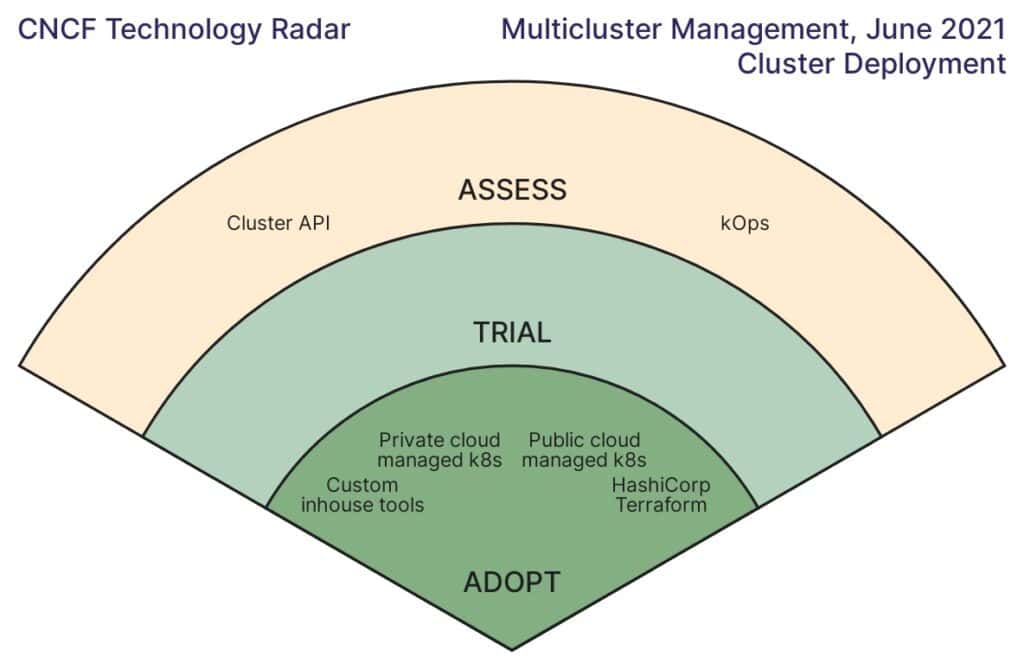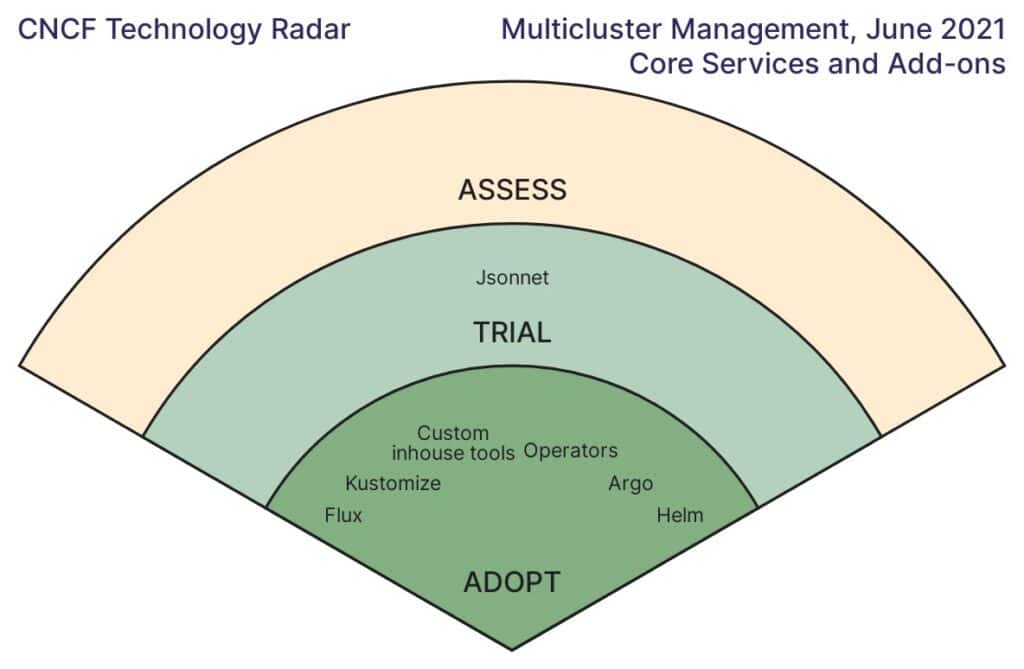End User Community reports that cluster management is complex with no defined path to success
SAN FRANCISCO, Calif. – June 23, 2021 – The Cloud Native Computing Foundation® (CNCF®), which builds sustainable ecosystems for cloud native software, today announced the findings of the fifth CNCF End User Technology Radar, a guide to a set of emerging technologies based on the experience of the CNCF End User Community. The theme of this edition for the second quarter of 2021 was Multicluster Management.


The growing popularity of distributed and multi-cloud deployments means organizations are running Kubernetes across many environments, including on-premise, public cloud, and edge. While this improves application availability, reduces latency, and makes it easier to scale both legacy and cloud native applications, it increases complexity as each cluster needs to be individually deployed and managed. The Radar team chose this as a topic because they found their organizations were all managing and deploying clusters in different ways.
“Multicluster management is still an emerging and complex space, so we wanted to gain a broader understanding of how organizations are doing it in the real world,” said Cheryl Hung, VP Ecosystem, Cloud Native Computing Foundation. “What we found is that there is no one size fits all solution for cluster management. Overall, approaches vary widely based on the number of clusters deployed and the management tools already in place, and custom tooling is usually necessary.”
After reviewing the data provided by end user organizations, the Radar team divided the solutions into two sub-categories, cluster deployment and core services and add-ons, to differentiate between tools used for deployment and those used to manage day 2 operations. The team summarized its findings in five key themes, which can be viewed in more detail on the Radar page.
Tools for managing core services, like DNS, metrics, logs, RBAC, and namespaces, outnumbered the tools for deployment on the Radar. They also received a higher total number of “Adopt” votes than deployment tools. The most widely used core services solutions are Helm, Operators, Kustomize, and GitOps tools Argo and Flux. Custom tools are used across both categories, while public and private managed Kubernetes and Terraform are popular solutions for cluster deployment. Only two solutions ended up in the “Assess” category, kOps and Cluster API, both solutions for cluster deployment. Many end users noted they are closely watching the development Cluster API, a Kubernetes sub-project, hoping it will reduce the need for custom tooling. Jsonnet for cluster services was the only tool in “Trial”.
“Compared with other Radars, we had more tools than ever in the Adopt category,” said Gabe Jackson, Cloud Platform Tech Lead at Mattermost. “This actually demonstrates how fractured the cluster management space currently is. Many organizations were almost forced into adopting many different specific tools for specific uses. As time goes on and Kubernetes deployments mature, we’ll see more consolidation of tools coming together to address a broader range of needs.
“Everyone starts with one Kubernetes cluster and expands and grows their environments from there, but currently there is no clear path for organizations starting this journey,” said Federico Hernandez, Principal Engineer at Meltwater. “In creating this Radar we wanted to document the available tools and processes so that organizations that are just starting can learn from organizations who have already been down this path.”
The CNCF Technology Radar is an initiative from the CNCF End User Community, a group of more than 140 leading-edge companies and startups, such as Airbnb, Capital One, and Twitter, who use cloud native technologies and aim to identify challenges and best practices when adopting them. The Technology Radar shares insight into which tools are used by end users and how and which tools end users recommend for broad adoption.
To learn more about the Radar results, watch the webinar with the Radar team and visit radar.cncf.io. You can also view previous Technology Radars on Continuous Delivery, Observability, Database Storage, and Secrets Management.
About the Methodology
In May 2021, the 140+ companies in the CNCF End User Community were asked to describe what their companies recommended for different solutions: Hold, Assess, Trial, or Adopt. They could also give more detailed comments. As the answers were submitted via a Google Spreadsheet, they were neither private nor anonymized within the group.
Twenty-four companies, including Adidas, Intuit, Squarespace, The New York Times, and Workday, submitted 210 data points. These were sorted to determine the final positions. The Radar Team then curated the responses, chose outcomes, and described any patterns or themes they saw in the data or from their own experience.
About the Radar Team
Gabe Jackson is a Cloud Platform Tech Lead at Mattermost. He has worked on various distributed systems over the years and generally enjoys the challenges in this space.
Federico Hernandez is a Principal Engineer at Meltwater, working with the internal platform offering based on Kubernetes. He has been a KubeCon + CloudNativeCon program committee member and chair for the Operations track.
Simone Sciarrati is an Engineering Team Lead at Meltwater, where he has been focusing on building an internal Kubernetes-based platform to make life easier for development teams.
Niraj Amin is Vice President of Cloud Platforms at Fidelity Investments, where he leads the engineering teams that work on Kubernetes-based platforms for all of Fidelity’s R&D teams, focusing primarily on offerings on multiple CSPs.
Rajarajan Pudupatti SJ is Vice President of Cloud Platform Delivery at Fidelity Investments, responsible for the architecture and delivery of the next-gen application platform.
Additional Resources
- CNCF Newsletter
- CNCF Twitter
- CNCF Website
- Learn About CNCF Membership
- Learn About the CNCF End User Community
About Cloud Native Computing Foundation
Cloud native computing empowers organizations to build and run scalable applications with an open source software stack in public, private, and hybrid clouds. The Cloud Native Computing Foundation (CNCF) hosts critical components of the global technology infrastructure, including Kubernetes, Prometheus, and Envoy. CNCF brings together the industry’s top developers, end users, and vendors, and runs the largest open source developer conferences in the world. Supported by more than 500 members, including the world’s largest cloud computing and software companies, as well as over 200 innovative startups, CNCF is part of the nonprofit Linux Foundation. For more information, please visit www.cncf.io.
###
The Linux Foundation has registered trademarks and uses trademarks. For a list of trademarks of The Linux Foundation, please see our trademark usage page. Linux is a registered trademark of Linus Torvalds.
Media Contact
Katie Meinders
The Linux Foundation